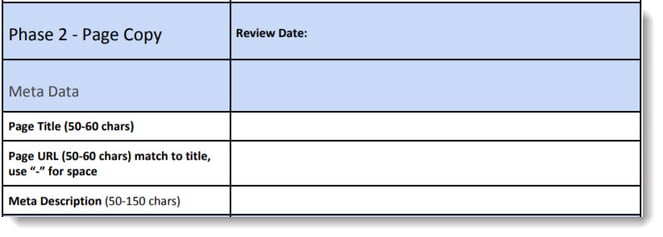3 min read
The Website Messaging Template That Will Improve Your Lead Conversions
![]() Monica Caraway
:
October 27, 2020
Monica Caraway
:
October 27, 2020

We work with a lot of SaaS startup companies, many of whom bring fresh and unique ideas to market. It can take quite a bit of research to establish the tone, messaging, and vernacular to use on their websites that will successfully garner sales leads. That research is aided through a strategic messaging workshop we hold with clients.
Startups have a lot of pressure in getting their online presence right. They are trying to woo investors and first-time/early customers. Too often, the priority is to put up a slick professional-looking site that is not well thought out in terms of messaging. Unfortunately, this does not help Google find them and serve up their website when prospective customers are making queries.
Have a plan
Before building or refreshing a website, establish each website page purpose. We have an outline and template that guides us through a two-phase process with clients.
Phase 1 - Discovery
Phase 1 is the discovery phase. Ask thorough questions about each section and page of your website, including:
- Who is the page for? (i.e., Is the content top, middle, or bottom in the sales funnel? )
- What is the problem you are trying to solve?
- What are you trying to communicate?
- What is the desired outcome?
- What are the CTAs (call to actions)?
Answering these questions ensures your messaging is focused and that everyone on your marketing team (internal and external) are on the same page. Messages are now more likely to resonate with your target audience on a per-page basis, and you have a guide to keep those messages consistent throughout the entire page.
With page plans mapped out, you are now ready to investigate what to say to achieve a page's objective. You can establish:
- If the keywords you are considering are likely to perform well. (Please see our post Identifying and Isolating Target Keywords for tips!)
- How your competitors are talking about some of these same ideas
- How your potential customers are responding to messaging
Case Study: From HubSpot to Hot Spot With a TMS SaaS Startup
Phase 2 - Writing
We'll give you that Phase 2, the writing phase, can be the longest and potentially hardest part of your process. This is where you bring it all together and define page and URL titles, draft meta descriptions, determine how page copy will flow, and generate the full text.
Slow down to go fast!
Why all this outlining and effort for each website page?
Two key reasons:
- You want Google to suggest your pages to people searching for answers to the problems your product can solve.
- Both your investors and prospective customers are often checking out your website before they talk to you or your sales team and you want them to understand exactly who you are and problem you solve.
Creating content for Google takes time. You want to invest time to research keywords and content that makes you stand out so Google will rank your website well. Unfortunately, in this day and age, only Page 1 of Google search results counts (search results 1-10). Living on Page 2 of Google search results (or beyond) will never help you capture new business (and, old joke, is the best place to hide a body).
In terms of your future customers, when they come to your site to investigate you, you need to stand out, demonstrate you can solve their problem, and that you understand them. You must speak their language and the a good story. Or they are just going to click away. Lead lost.
The template
Our website messaging template helps you outline each website page by asking the right questions to get to the heart of the objective. The template also acts as a checklist for those who are new to creating website copy. It requires you to identify elements that are important for search engines to find your page.
We use this template with our clients to help hone their objectives and directives to our team. It works exceptionally well in meetings too when teams are brainstorming through ideas and research. And by sticking to this format, and clear cut goals for each page, it provides a framework for team members to explain why something should be a certain way, and negotiate with their colleagues.
We encourage you to check it out!
Additional Resources
- Why HubSpot's CMS is a WordPress Killer
- SaaS Startups: Eight Reasons to Build Your Website on HubSpot CMS
- Why Host Your Website on HubSpot & How to Migrate Websites to Hubspot's CMS
- Migrating From WordPress to HubSpot: Step-by-Step Instruction
- 5 Minute Video: Why Content is So Important for Your Startup
- Easily Create Content for Your Startup's Product Launch



